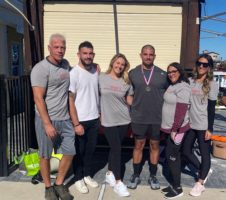
Jesse Shea is a former college athlete who at age 26 lived an active and healthy lifestyle. One morning in November 2019 while the Cape May, NJ resident was preparing for work on his boat, he began feeling strange. The last thing he suspected was stroke. Soon after, he had very little movement on the right side of his body and could not control the water from dripping down his mouth. He rushed to the hospital.
“I knew something was wrong because I had felt off all morning, but I never suspected I was experiencing stroke symptoms,” Shea said. “I thought I was too young. Now, I wish I would have gotten to the hospital sooner.”
Shea spent the following six months in and out of the hospital re-learning to walk, talk and do every day basic things, like brushing his teeth. He recalls the challenges and setbacks he had to overcome to return to his pre-stroke health.
“I had to overcome the many physical and mental hurdles that come from having a stroke at age 26,” Shea said. “When your life is put on hold and you are forced to rely again on family, it takes a toll on your mental well-being.”

Shea has spent the last year “trying to come to terms with his new life” and working with his doctors to determine the cause of this stroke. He is trying not to dwell on things he can’t control and instead is putting all of his focus on his recovery.
As a former college soccer player, one of his goals was to run again. In November 2020, he completed a half marathon in his hometown with the help of family and friends. The town came out to cheer him on and together they raised more than $10,000 for the American Heart Association. Completing the half marathon was a major step on the journey to recovery but he knows the road ahead is long.

“While I am very proud of my progress and this accomplishment, I want to do more,” Shea said. “If I would have known that stroke can happen to people my age or if I would have been aware of the signs to recognize a stroke, things may have been different.”
While recent studies suggest stroke incidence is declining in the general population, stroke incidence and hospitalizations have increased by more than 40% in young adults in the past several decades. According to the American Heart Association, 10 to 15% of the nearly 795,000 people in the U.S. who have a stroke are young adults between ages 18-45.
However, a survey published in October 2020 found that nearly 30% of adults younger than 45 do not know all five of the most common stroke symptoms.
These symptoms include: numbness of face/arm/leg; confusion/trouble speaking; difficulty walking/dizziness/loss of balance; trouble seeing in one/both eyes; and severe headache.
The American Heart Association advocates the use of the letters “F.A.S.T.” to spot stroke signs and to know when to call 9-1-1:
• Face drooping
• Arm weakness
• Speech slurred
• Time to call 9-1-1
